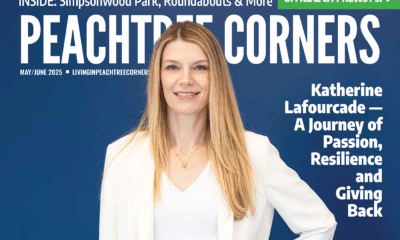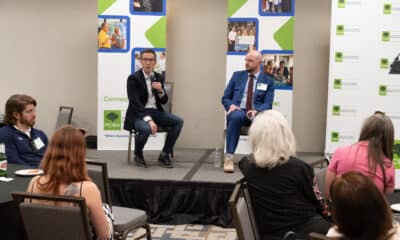Arts & Literature
Wesleyan Artist Market Celebrates Its Silver Jubilee in 2023
Published
2 years agoon
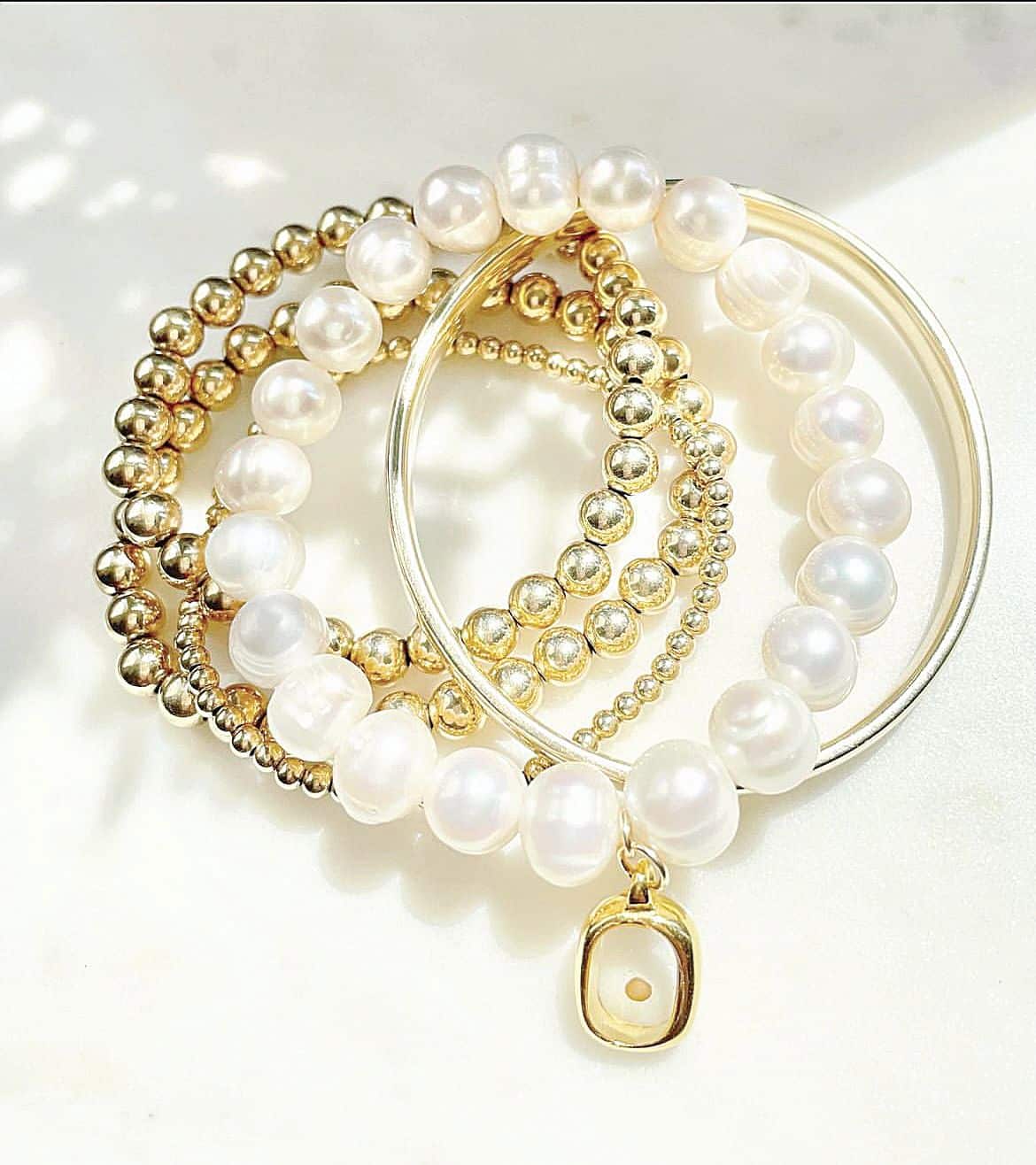
This spring ushers in the 25th annual Wesleyan Artist Market (WAM), our favorite local fine art, jewelry and fine wares show. It’s set for Friday, April 28, 10 a.m.-7 p.m., and Saturday, April 29, 10 a.m.-3 p.m. at the Wesleyan School in Peachtree Corners.
Enjoy scrumptious beverages and snacks while taking in the talents of 85 professional artists from all over the Southeast and 19 student artists. This two-day event is open to the public; parking and admission are free.
Engage with artists as you hunt for works that you’ll treasure for years to come. “Come to the Table,” Wesleyan’s hardcover cookbook with over 200 recipes, will be available for purchase. Proceeds help fund Wesleyan’s fine arts programs.
This year, your support will facilitate the purchase of a new truck for the marching band, the refurbishing of a Steinway piano, new chorus risers and upgraded lighting in Powell Theater.
From casual customers to avid collectors, WAM always delights. To preview participating artists, visit artistmarket.wesleyanschool.org. Cheers to 25 years, WAM!
Spotlight on three artists
Wendy King — Poppy and Jewel
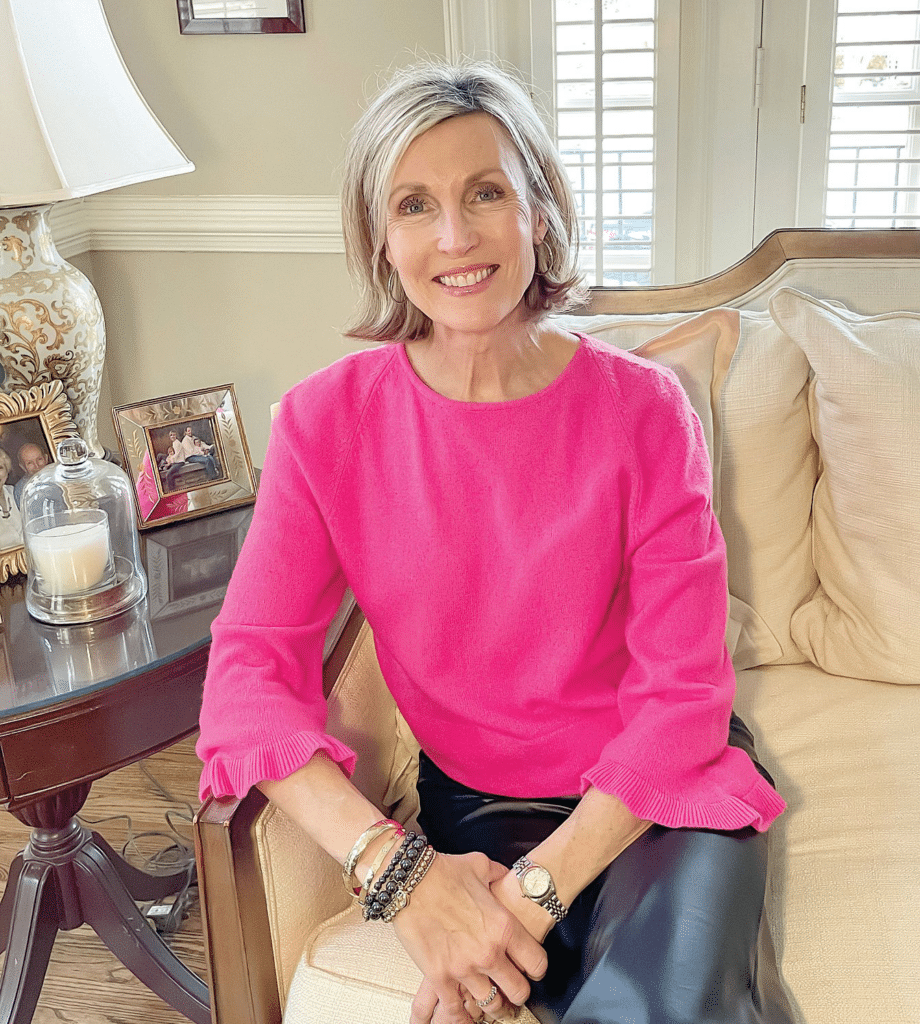
Inspirational jewelry that cuts the mustard
When Wendy King received a spherical, vintage charm containing a single mustard seed from her husband’s grandmother long ago, she had no idea it would be the catalyst for starting her own inspirational jewelry line one day, nor that it would have such a profound and far-reaching impact on others.
In the 1950s and 60s, it was apparently customary to gift such charms, alluding to the parable of the mustard seed. Some were set in brooches, many hung on necklaces.
King found it was very effective to wear the sentimental trinket she had received as a reminder to walk in faith every day. She elected to sport the bauble on a stylish new bracelet and realized that women today would be more likely to benefit from continuing this tradition if the cherished charms of yesteryear with real mustard seeds inside were set in more contemporary, fashion-forward jewelry pieces.





“A lot of the religious jewelry has a similar look. I wanted to elevate it, put a different spin on it,” King said.
She thought she could breathe new life into these vintage charms by using them to create contemporary jewelry pieces. “I went to antique stores, but it was like finding a needle in a haystack, especially to find them in good shape. That’s when I realized I’d have to make the charms myself too,” she added.
Today, her Poppy and Jewel pieces are made with natural gemstone beads like white lace agate, amazonite, aquamarine, pearl, tiger’s eye, labradorite, hematite and river stone and her perfected bezels with metal finishes in silver, polished gold or antique brass. Each one contains a solitary, immortalized, goldish-brown mustard seed suspended in the center of a clear resin-filled charm.
“You don’t have to see the whole staircase; just take the first step.” – Martin Luther King
It’s a powerful visual, to see how physically tiny a mustard seed really is. King painstakingly creates lovely earrings, necklaces and bracelets — vessels that spark the might of faith when worn.
Her jewelry line speaks with the promise that if you believe it, everything will work out for the best. Each distinctive piece comes with a card explaining the parable that inspired it.
Faith can move mountains — pass it on
Jesus says in Matthew 17:20, “For truly I tell you, if you have faith the size of a mustard seed, you will say to this mountain, ‘Move from here to there,’ and it will move; and nothing will be impossible for you.”
It’s a message that transcends all faiths and provides comfort whether you’re religious or not. We all go through low points when digging deep to find the strength to triumph is vital.
Even the smallest amount of faith in an all-powerful God, or an ever-just universe, results in great things. Sometimes life’s tests may seem insurmountable: divorce, job loss, infertility, illness.
That’s when you must believe in your heart, without a doubt, that God or the universe is bigger than those mountains. It’s hard to do in our we-have-to-see-it-now-to-believe-it society. Enter Poppy and Jewel. Cue “You Gotta Have Faith” (George Michael, 1987)
King has enjoyed witnessing the organic growth of the one-woman enterprise she started in 2016 named after her maternal grandparents who planted the seeds of faith in her. The ripple effect of customers sharing her pieces is special.
“I can’t tell you how many times I’ve had people tell me they hear stories that grip their hearts and give their bracelets away to comfort someone in need. Then I get an email, “Well, I gave another one off my wrist. I need to restock.” That’s what it’s for. You hear somebody going through a rough patch and you pass it on,” King smiled.
The evolution of an artisan
A bachelor’s degree in government administration didn’t exactly allow King a creative outlet. Nor did her 12-year stint as a fitness instructor at Country Club of the South. She founded Poppy and Jewel when her kids were still in school, and she was able to ramp production up or down as needed. “Now that they’re grown, I can devote so much more to it,” King said.
Producing her pretty, handcrafted pieces took plenty of trial and error. “The first time I worked with the resin, I poured it, set the seed in and wondered why it was gooey. It took years of making charms that I can’t use. Those little boogers float around,” she laughed.
Lately, King has been working with a company to replicate the vintage charm that started it all for her. They are three samples into tweaking a spherical bauble with a metal band around it that should be available in a few months.
Behind the scenes
Removing air bubbles in the resin, stringing smaller beads one by one with a needle and thread, perfectly positioning the seeds — it’s tedious work.
If the resin mixture isn’t spot on and perfectly timed, it doesn’t cure correctly. It’s all part of learning what works. “I’m very methodical now. I follow the same steps every time. I don’t want any mishaps,” King explained.
This jewelry line is a true labor of love for King who has since fine-tuned her two-step resin pouring process. Still, every phase of a successful batch of charms has to be completed within a certain window. She purchases the bezels (the empty metal part), mixes the resin with hardener, pours it and positions the itty-bitty mustard seed in the center while wearing glasses and a magnifying glass.
King patiently allows it to cure, but she must also check on them at exactly the right time to be able to redirect any seeds that may have drifted. Once that stage has cured properly, a second round of resin is poured.
King prefers to work on small batches of about 100 charms at a time. “When inspiration hits, I’ll go to my studio down the hall and work while those juices are flowing and I’m in that creative mindset, whether it’s crack of dawn:30 or late at night,” she said.
Shop Poppy and Jewel
Shop King’s handcrafted jewelry in person at WAM, The Red Hound in Norcross and Alpharetta, Under the Palm Tree in Dunwoody, and Josephine’s Antiques in Roswell. Electronically, visit her website, poppyandjewel.com, or Instagram account, @poppy_and_jewel.
Customizations include requests for particular colors, smaller or larger sizes. Some people bring their own beads or a broken necklace to be used. If you find a vintage charm after rifling through your family’s jewelry boxes, you can have it added to Poppy and Jewel bijouterie.
“If it brings a sense of joy or hope to somebody, if I touch one person’s life, then I’ll keep doing what I’m doing,” King declared.
Shane Miller — Artist

Stumble into art
Maryland native Shane Miller did just that, and he’s been swimming since 2016. Miller transferred to Nashville in 2013. He always knew he’d do something creative full time, but he didn’t realize it would be painting until a chance encounter at an art crawl with Paul Polycarpou, then CEO of Nashville Arts Magazine, changed his instrument from guitar to paintbrush.
Miller had already hung up his physical therapist hat after six years in the field to pursue music. His father introduced him to guitar early. He took lessons at age 10 and was giving them by 15.
Strumming for a living wasn’t much of a stretch. For most, it would be a giant stretch. For musical Miller, easy peasy.
Touring on weekends with an independent artist, his year in the life of a professional musician allowed more time for painting. Eventually, the music volume decreased as the painting volume amplified.
A natural knack
“I had a watercolor tutor in high school. Before that, I’d draw on the back of my worksheets in elementary school. I have a natural knack for it,” Miller stated.
Miller clearly paid attention in watercolor class where he learned the fundamentals of color theory and composition. Through college and thereafter, he painted in his spare time.
After trying different styles, he settled on creating what most resonated with him: abstract, atmospheric landscapes influenced by tonalism like those one might recall from a reverie or a distant memory, using oils on canvas.
Miller took Polycarpou up on his open-door policy for local artists. The executive was open to critiquing artists’ work and had offered to introduce Miller to a gallery in town when he believed him to be ready.
True to his word, Polycarpou provided direction and in a short time, Miller signed with the Rymer Gallery. Others ensued.
Needless to say, the painter isn’t missing his regimented physical therapy days. He considers his flexible schedule a dream. “I’m happy with my career. It was an interesting road getting here,” he said.
The sway of social media
Curating a cohesive Instagram story and posting regularly paid off for the promising artist. The platform revealed a market for his work. Miller was both astonished and assured by people’s readiness to buy paintings online.
“I’ve shipped work all over the world: the UK, Australia, Japan, the Philippines, Germany — all through the power of the internet,” Miller said.
Studio space
Miller works out of his Germantown studio with soaring ceilings, a massive north-facing window and skylight in an old flour mill that’s been converted into a business collective north of downtown Nashville.
A believer in being disciplined, he reports to his atelier daily, inspired or not, “You have to be consistent with showing up. Diving in allows creativity to start flowing.”
The painter’s process
Miller finds inspiration in his travels. He doesn’t work from reference photos; he finds them restrictive. Surprisingly, he doesn’t aim to depict any particular panorama. He paints from his imagination.
More interested in expressing himself and capturing feelings, he seeks to take viewers on a spiritual voyage. “Painting is a subconscious process for me, like meditation,” he explained.





Miller paints bodies of water because, besides being visually interesting, they create lines leading the eye into the composition. It evokes turning a chapter, especially flowing rivers.
His monochromatic, non-specific landscapes act as a bridge to tap into emotions. He’s pleased when people feel like they’ve been to “that place” in any of his paintings.
A prolific painter, his preference is to juggle about six pieces at once. “I paint skies on different days than the foreground, working in batches. I’ll mix a certain color and carry it throughout multiple paintings so I’m not wasting paint. It’s a nice way to streamline things and jump around through different pieces,” Miller said.
Stepping away frequently when working on multiples allows him to avoid tunnel vision, “I can always reassess the direction.”
Most paintings are varnished once he’s done. He likes the subtle finish of satin varnish mixed with cold wax for a less reflective sheen.
Mystery blooms
“Recently I’ve been painting abstract florals. There aren’t many rules when painting florals,” Miller stated. One gets the impression he wouldn’t follow any if there were. He enjoys using brighter colors than he would in his landscapes.
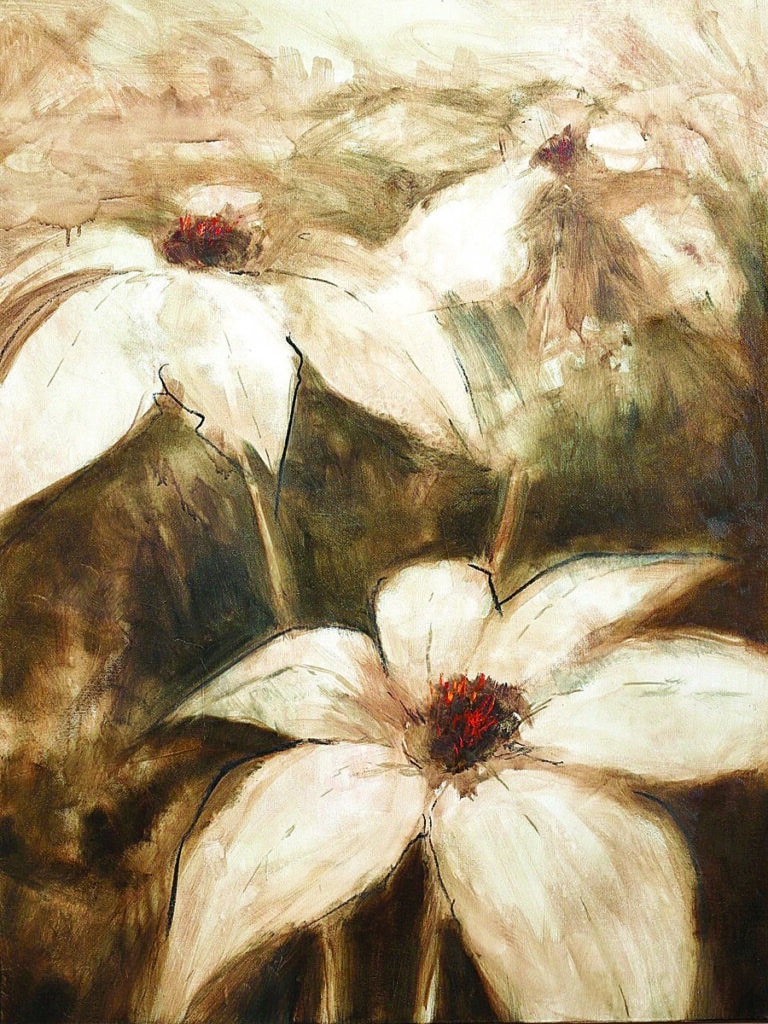
“I don’t know one flower from the next. I just paint whatever shape looks great and my wife will say, “That looks like a lily.” For Miller, it’s about creating a composition that feels right.
A left-brained creative?
Miller has a penchant for numbers and organization. “I have systems to keep track of everything,” he said. His paintings have an identifier that correlates to a spreadsheet and an internal tracking system. He can trace any piece, whether it’s at the studio, at a gallery or sold.
Miller dove into the accounting cycle and relishes keeping up with his books. Documenting his endeavors makes him feel accomplished.
A logbook holds records of the colors and dates of every layer of every painting — all steps taken to achieve the end result. These come in handy when clients request something similar to one of his older works.
“Painting is a very subtle thing, especially working in layers. It could be hard to recall every step,” Miller explained.
Commissions
At shows like WAM, you might not find exactly what you’re looking for, but if you like his style, Miller can create a unique piece for you. One can request a painting reminiscent of a location — the Carolinas, a marsh, the coast or mountains — and any desired elements for the piece.
Miller then gets to work. A 20% deposit gets the ball rolling. Within a month, one can expect to see photos and videos of a piece for final approval.
Shop Shane Miller Art
Meet Miller and see his work at WAM. So that buyers can purchase with confidence, he is responsive to inquiries from his website, shaneartistry.com or through Instagram @shane.artistry.
“Art washes away from the soul the dust of everyday life.” — Pablo Picasso
Miller espouses Picasso’s sentiment. He feels painting or any creative outlet is an escape from the mundane and rejuvenates the spirit.
Jennifer Keim – JKEIM Fine Art and Lifestyle Design
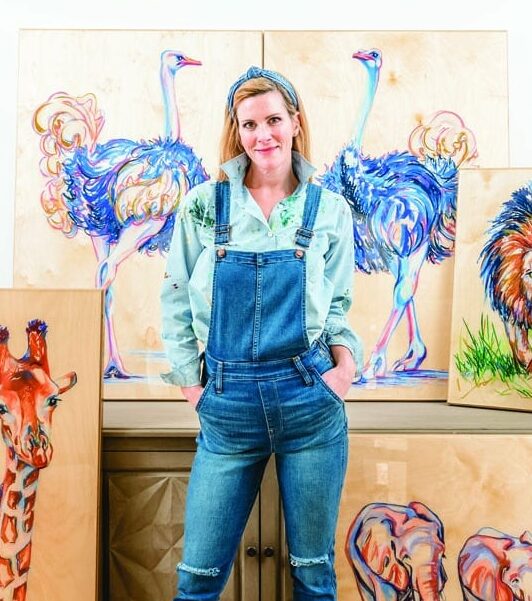
Becoming JKEIM
Atlanta artist Jennifer Keim switches between oils, pastels and mixed media to best capture her subjects’ personalities. She’s been fostering her artistic talent since fourth grade at the behest of the late Jill Chancey Philips, a summer camp instructor at the Columbus Museum who noticed she had something special.
Keim studied under Philips until earning a Bachelor of Fine Arts in drawing and painting at Auburn University. Philips owned the gallery and studio where Keim spent her young adult summers learning the business side of being a professional artist.
She credits her mentor for emphasizing grit and form. “It’s so important understanding technique before you can evolve your style. You have to understand dimensions, perspectives and shading to bring a subject onto the page,” she said.
Keim worked in advertising for practical reasons until a successful solo art show convinced her she could do art full-time. She felt “suffocated” behind the computer, so in 2007 she left graphic design for a career as a painter.
Art therapy
An unfinished space in her home is Keim’s special place. Nails dot the walls where pieces have come and gone. Paint and resin splashes adorn the studio floor. Her beautiful work surrounds her on all sides.
Seeing how color and shadowing can bring the beauty of a subject up off the page has always intrigued Keim for whom painting is a creative outlet. “It feels good. If I’m a little cranky, my husband says, ‘You might need to go to the studio for a bit.’”



Off to the Races
The jockeys and detailed horses of the pastel-on-wood Off to the Races series feature clean lines and vibrant colors. Keim captures the energy of the horse races. “My favorite part is doing the kickup,” she said.
Fun fact: Mud can splatter up to 20 feet behind a galloping horse.


Starting with a pencil drawing is key as the nonporous wood allows for only one or two strokes of pastel. After 20 years of working with high gloss resin, Keim is still surprised by the chemical reaction that occurs when it’s poured over pastels on raw wood. It enriches the woodgrain, melts the pastels heightening the colors and creates an almost 3D effect.
The family is warned before a resin session begins with “Do not enter; mommy is pouring.” Then it’s literally off to the races. It takes two to three minutes to precisely mix the concoction of resin and hardener and another 15 minutes to pour the epoxy before it gets too sticky.
Keim releases air bubbles with a torch and walks away for three days, hoping no bugs land on the curing resin. The finished pieces, with their glossy sheen and beveled edges, do not require a frame.
Generation Wild collection
An African safari in 2009 left Keim forever enchanted by the way of the wild — how the animals communicate, the smells, the circle of life. “It makes your heart beat in a different way. I still get chill bumps from it,” she said.
Capturing animals is all in the eyes in Keim’s view. “Start with the eyes. If you don’t get them right, you might as well start over,” she explains. “I have to feel like they’re blinking at me before I can move on.”





Fly Guys
“My Fly Guys collection started from my husband’s grandfather’s fly box in the studio. I was up late one night and started tinkering around with it. Creative moments,” Keim said.


Textiles
Whose Booze? It’s what Keim likes to call her set of four hand painted linen cocktail napkins with a hemstitch, each in a different color for easy glassware identification. They’ll be available at WAM for the first time this year.


Keim also makes tea towels, scarves that double as cover-ups and more. The painted fabrics are durable and washable.
Shop JKEIM
Find Keim’s artwork and textiles at WAM, Marguerite’s in Brookhaven, B.D. Jeffries in Atlanta or visit her website, jkeim.com.
A day in the life
“I jump around like a ping-pong ball, which keeps me in the groove” is how Keim describes her workday. There are textiles drying on tables and on the floor, scarves on mannequins. It’s a carefully timed game of drying stations in anticipation of the next color. Snuck in between is a layer being added to an animal piece.
She prefers coastal and mountain pieces in oils with visible palette knife blade marks. “I like to work with oil on linen or canvas with a venetian red backing. I was trained to emulate the masters,” she said.
Keim keeps a supply of canvases painted with a venetian red basecoat in all sizes at the ready, in case there’s something she wishes to paint immediately.
Commissions
Keim completes commissions of all sorts. Even her textiles can be personalized. Pinpointing what the client is interested in comes first. Next, learning what the space is like.
She’s been known to bring an assortment of works to homes to see what size works best with the ceiling height and the environment. A 50% deposit gets a commission underway.
The best part
Keim wants her work to incite nostalgia, cheer and joy. For her, the best part about being an artist is having people connect to a piece she was inspired to create.
“You’re getting a little piece of me in every one of my original works,” she said. “When all those happy moments combine, that really is magical for me.”
See you at WAM’s 25th!
I’m positive you’ll enjoy meeting these gifted artists at WAM. The show is the springtime indulgence we’ve all come to expect. Exhibitors are looking forward to meeting you and sharing their zeal for art with you.
Thanks for one exquisitely imaginative quarter of a century, WAM!
Related
Patrizia hails from Toronto, Canada where she earned an Honors B.A. in French and Italian studies at York University, and a B.Ed. at the University of Toronto. This trilingual former French teacher has called Georgia home since 1998. She and her family have enjoyed living, working and playing in Peachtree Corners since 2013.

Arts & Literature
Experience Shakespeare in the Park with Contemporary Classics’ Twelfth Night
Published
4 weeks agoon
April 11, 2025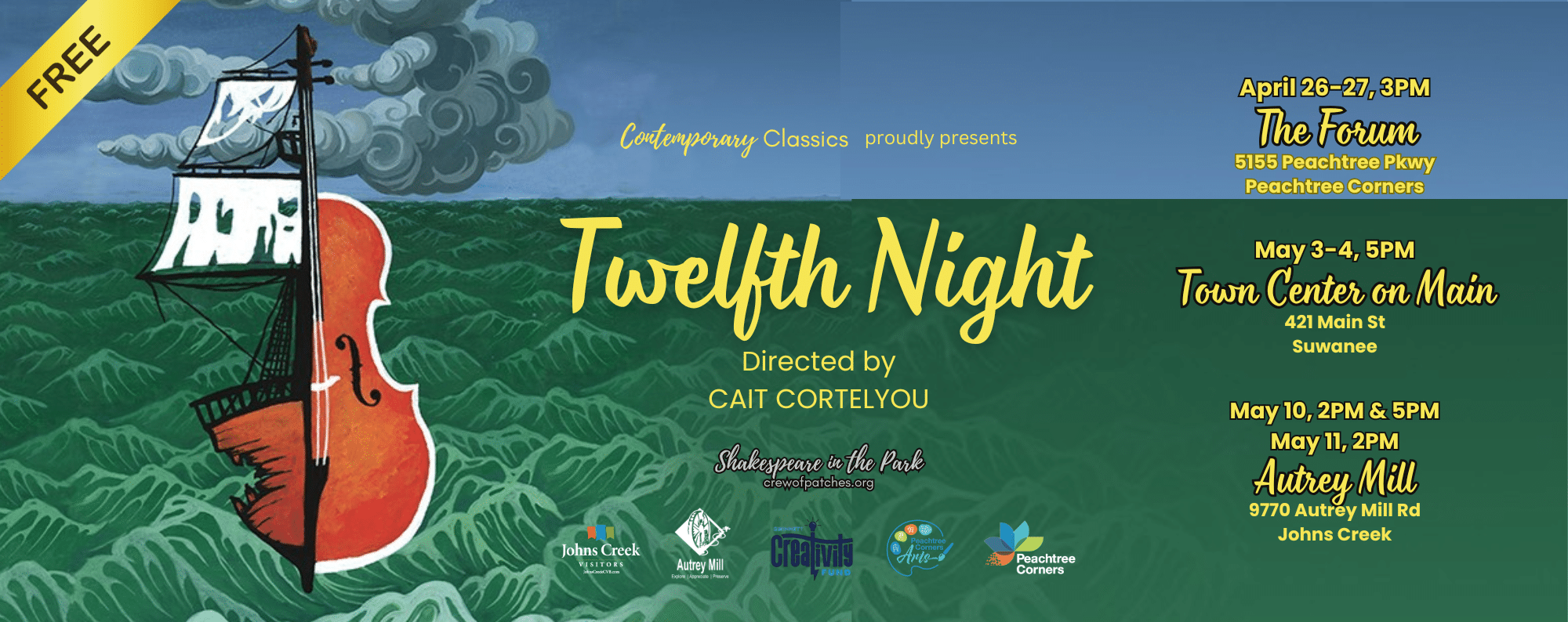
Contemporary Classics Theatre will present Twelfth Night, a free “Shakespeare in the Park” experience at three beautiful outdoor venues in north metro Atlanta
Twelfth Night, William Shakespeare’s romantic comedy of mistaken identity, will play at three beautiful outdoor venues in north metro Atlanta from April 26 to May 11.
Directed by Cait Cortelyou, known for her award-winning feature film “Ask for Jane,” Twelfth Night is a rollicking ensemble comedy explores unrequited love, misperceptions and the instability of gender.
Set in the coastal town of Illyria, young Viola survives a shipwreck and finds herself alone, believing that her twin brother died at sea. Disguising herself as a man, she finds work with the Duke Orsino, quickly falling in love with him. Orsino, however, is in love with the Countess Olivia… and Olivia quickly falls for Viola.
Meanwhile, Olivia’s steward Malvolia has bullied the household for the last time — and the staff is out for vengeance.
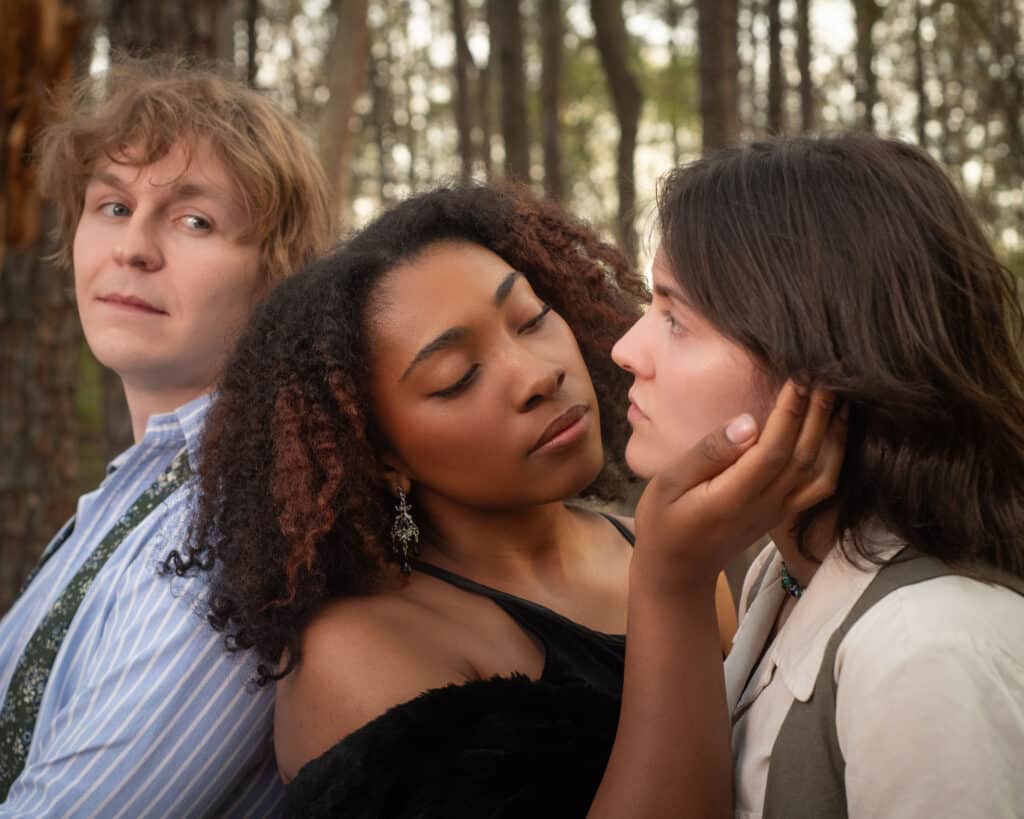
This timeless production of Twelfth Night features Allen Cox, Carl Fisk, Ryan Hutchins, Shem Louis, Susanna Lyne, Steven Medina, Matt Metzger, Danielle Montgomery, Macros Nora, TJ Sanson and Elliott Posadni as one of the first transgender actors to play Viola.
It also features costumes by artist Jordan Hermitt and production design by Sage Kim Gray.
Locations, dates and showtimes
The Plaza at The Forum Peachtree Corners • April 26–27 at 3 p.m.
Audience seating and a special musical performance will start at 2:30 p.m. Please note that seating is limited; arrive early and/or bring lawn chairs or blankets. Food and drink are available for purchase at the venue.
Town Center on Main, Suwanee • May 3– 4 at 5 p.m.
Audience seating and a special musical performance will start at 4:30 p.m. Please note that no seating is provided; bring lawn chairs and blankets. Coolers are welcome (no alcohol). Food trucks will be onsite at the venue.
Autrey Mill Nature Center, Johns Creek • May 10 at 2pm & 5 p.m.; May 11 at 2 p.m.
Audience seating and a special musical performance will start at 1:30 p.m. on both days and at 4:30 p.m. for the evening show on May 10. Limited bench seating only. In case of inclement weather, the show will move from the amphitheatre to the open-air Pole Barn nearby.
Admission to the shows is FREE. Register online for tickets.
About Contemporary Classics
Contemporary Classics exists to challenge and transform classic Western theater traditions by creating an inclusive community of diverse people, ideas and cultures. They believe that classic work is made even greater when performed by a larger variety of artists — especially those who have been marginalized by Wester theatre traditions — including women and people of color.
With no permanent home, the theatre company partners with places such as public parks for performance spaces. This “homeless” state is one of the reasons they call ourselves “a crew of patches”— they travel from “patch” to “patch” with their shows.
The name also comes from a line in A Midsummer Night’s Dream, and reflects the “motley” coat of a Shakespearean clown (or fool), created by sewing patches of old or discarded clothing together in a mishmash of textures and colors, like a patchwork quilt.
Fools, or “Patches,” transcend societal norms by being simultaneously a part of society and outside of it, giving them the ability to examine and comment on it.
For more information, visit crewofpatches.org.
Related
Arts & Literature
From Food Creations to Handmade Jewelry: Wesleyan Kids Prep for Artist Market 2025 [Podcast]
Published
1 month agoon
April 7, 2025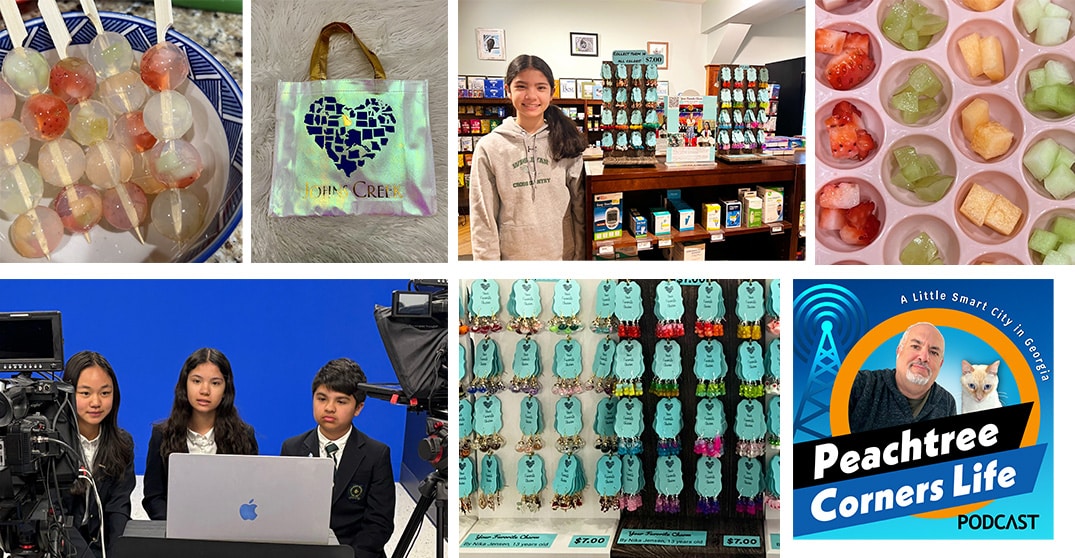
In this episode of Peachtree Corners Life, host Rico Figliolini spotlights three remarkable student artists featured in this year’s Wesleyan Artist Market. Eighth graders Kimberly Wang and Nika Jensen, along with sixth grader Carter Jensen, share their creative journeys—ranging from edible art like fruit jellies and peppermint bark to handmade jewelry and custom-designed bags.
Kimberly talks about her love for food art and balancing sweetness with fruity freshness, while Nika and Carter discuss building a jewelry business that also gives back—donating proceeds to families in the Philippines. This isn’t just an artist market; it’s a showcase of purpose-driven, globally inspired young talent. The event runs April 25–26 at Wesleyan School and is open to the public.
Podcast Takeaways:
- Kimberly Wang creates handmade edible treats, balancing flavor and freshness for the show.
- Nika and Carter Jensen co-run a jewelry and fashion accessory business, inspired by global travel and cultural experiences.
- Nika donates part of her proceeds to support families in the Philippines.
- All three students are deeply involved in extracurriculars—from musicals, marching band, math club, and academic bowl.
- The Wesleyan Artist Market features 24 student artists and over 70 professionals—open to the public April 25–26.









Timestamp:
00:02:19 – Student intros and extracurriculars
00:03:06 – First-time participants and motivations for joining
00:04:13 – Kimberly’s edible art and recipe testing process
00:05:16 – Nika and Carter’s jewelry and bag design business
00:07:06 – The reward of watching people enjoy your creations
00:08:20 – Donating art profits to support families in the Philippines
00:10:39 – Future aspirations in medicine and law, with art as a passion
00:12:06 – Behind-the-scenes logistics of preparing for the market
00:13:25 – Global travel inspiration: 73 countries and counting
00:17:19 – Where the students draw artistic inspiration
00:20:04 – Custom requests: From peppermint bark to Lego earrings
00:21:16 – Anticipation and excitement for this year’s market
00:22:29 – Reflections on Wesleyan and the artist experience
Transcript:
00:00:01 – Rico Figliolini
Hey, everyone. This is Rico Figliolini, host of Peachtree Corners Life. We have a great set of guests today. Because of the upcoming Wesleyan Artist Market, we thought we’d do some interviews with student artists. Three of the 24 that are going to be at Wesleyan Artist Market. So they’re with me here today. So we’re going to get right into that shortly. I just want to say thank you to our corporate sponsors. So I want to say thank you to EV Remodeling, Inc., based here in Peachtree Corners. The owner is Eli. Him and his family live here. They’re great. They do a lot of design work, design your space. Essentially, any home remodeling you need from whether it’s your kitchen, your bathroom, or a whole house remodel, or even an addition to your home, think about it, whatever you need, Eli can handle. So check them out. Go to evremodelinginc.com and find out how they can design your space and your life. Our next sponsor just came on, and they’re Vox Pop Uli. I want to thank them for joining us as well. They deal with all sorts of things you can imagine putting your logo on, similar to a little bit about what these kids do, right? They’re creating artwork. They’re creating a brand for themselves. And so this is what Vox Pop Uli does, right? They’ll take your brand and bring it to life. Essentially, anything that you can think of that would go on apparel, whether it’s sweaters or T-shirts or wherever you want to put your brand engraving, your logo, what object you want to put it on, even vehicle wraps. So if you’ve got a truck, you want to put a whole wrap around it, check them out because they can do that. They’re here in Peachtree Corners and they’re called Vox Pop Uli. So visit their website. I’ll have the links in the show notes as well. So thank you guys. I appreciate your support. So now let’s get right into it. Let me introduce our three artists, great Wesleyan students. Can’t wait to start talking to them. We have Kimberly Wang first on your left, on my left, and Nika and her brother Carter Jensen, who work together creating the artwork they do. So I’m going to ask you guys just to, you know, give me a little background. Tell me who you are, your grade, what you do, extracurricular, stuff like that. This way our audience can get to know a little bit more about you. So let’s start with Kimberly Wang. Hey, Kimberly.
00:02:19 – Kimberly Wang
My name is Kimberly Wang. I’m in eighth grade this year, and outside of Artist Market, I do marching band, and I also do the musical production this year, which is Matilda.
00:02:31 – Rico Figliolini
Excellent. What about Nika? How about you?
00:02:34 – Nika Jensen
I’m also in eighth grade. My name is Nika Jensen, and apart from doing the Artist Market, I do cross country. I’m also in Matilda this year, and I also do math counts, which is a math club.
00:02:47 – Rico Figliolini
Okay, cool. And Carter?
00:02:49 – Carter Jensen
Hello, my name is Carter Jensen. I’m in the sixth grade. And outside of the artist market, I do academic pool and I also do basketball.
00:03:00 – Rico Figliolini
Excellent. Alright, cool. So have you guys ever done the artist market before? Is this the first time?
00:03:06 – Kimberly Wang
This is my second year doing it this year.
00:03:08 – Rico Figliolini
Second?
00:03:10 – Nika Jensen
Yeah, this is our first year because we’re new students this year.
00:03:13 – Rico Figliolini
Alright, cool. What inspired you to get into it, Nika?
00:03:17 – Kimberly Wang
Well, I had my own business before we came to Wesleyan and so I thought that the artist market is a good way to like show my business to other people in our community. So yeah.
00:03:30 – Rico Figliolini
And you brought in your brother Carter to help you with?
00:03:35 – Nika Jensen
Yes, sir. He’s also part of the business.
00:03:39 – Rico Figliolini
Alright cool. Okay so, Kimberly. Food. Food is art, right? I’m sure your mom would probably say, it’s food, just eat it. But you’re playing with your food, essentially. What they used to tell you not to do, right? So when you create your food art, what do you think about? How do you go through this? How do you choose what you do and what do you exactly do?
00:04:13 – Kimberly Wang
So this year, I am making fruit jellies and peppermint bark. And when I think about what creations I want to make for the artist market, I go online and I look through like, what are some popular desserts that a lot of people like? And once I like choose my items, then I go through
the recipe and then I do a lot of trial and errors to make sure that like the products are like healthy and they taste well.
00:04:42 – Rico Figliolini
So they have to be edible, right? Because this is edible art?
00:04:45 – Kimberly Wang
Definitely, yes.
00:04:46 – Rico Figliolini
So are you eating a lot of the edible art before you get to what you need?
00:04:50 – Kimberly Wang
Not really. I don’t usually taste a lot of the food. I let my family taste it.
00:04:56 – Rico Figliolini
Ah, good. I like that. Yes. Get them to participate. Cool. So edible art, that’s one way of doing it. Jewelry, that’s something else, right? Wearable. How do you guys, Nika, Carter, how do you get to the place of what you do?
00:05:16 – Nika Jensen
So I started my business when I was 11 years old and it started like I got my first jewelry making kit and I kind of just expanded from there. So like I usually use Amazon to search and find like the prettiest designs like of earrings and pendants and get opinions from other people like my mom and my family to see like if they think it’s like wearable and if they like it. So I browse on Amazon for a while and I find like the best and high quality products and then I hand make them at home usually like every day after I come home from school so and my brother he does something else and he can tell you about that.
00:06:01 – Carter Jensen
I, my sister, she got a Cricut machine for, like, her 12th birthday, I think. And started making these, like, iron-on bags with the Cricut machine and, like, making them based on, like, Georgia and, like, Wesleyan and designing it based on fashion.
00:06:19 – Rico Figliolini
Alright. Cool. So let’s get back to Kimberly. The food that you do. Do you have particular flavors you like? Do you have particular areas that you stay in?
00:06:33 – Kimberly Wang
So this year I’m trying out like something more sweet with chocolate. But last year I definitely went for more of like the fruity side. And I think I like to keep it like a balance. So that way one is not overpowering the other. My personal favorite will probably be fruit because it’s healthy. And I mean, it just tastes good in general.
00:06:56 – Rico Figliolini
Okay. Alright cool. What’s the most rewarding part that you can think of, of making edible art?
00:07:06 – Kimberly Wang
Well, I mean definitely like you said before you get to eat a lot of food. I mean, I did say before that I don’t eat a lot of the creations I make, but sometimes I still do eat it. And so I think it’s also really rewarding to see like people try out your creations and see like their reactions to what they think of it.
00:07:27 – Rico Figliolini
So when, I know I’ve spoken to other artists when they sell their artwork like paintings or stuff like that they get a chance to see it sometimes when the fan that bought it if you will, would send them a picture of where they hung it right? Yours disappears right?
00:07:45 – Kimberly Wang
Yeah, exactly.
00:07:47 – Rico Figliolini
Yeah I guess, there’s no way to, short of doing a selfie with it or taking pictures of it, there’s no there’s no permanency to it so how does that feel?
00:07:57 – Kimberly Wang
I mean well as long as the people enjoy it that’s good. And I mean I think mainly it’s about like the memory that you have of having the food and if you like it then it stays as a good memory for you and if you don’t then I mean you can always try out different things.
00:08:20 – Rico Figliolini
Okay. Nika, Carter, as far as the jewelry goes the, you’ve used it to raise money to support children in the philippines? yes
00:08:29 – Nika Jensen
Yes sir.
00:08:31 – Rico Figliolini
Is that, is that how you started this when you were 11? Is that the reason?
00:08:35 – Kimberly Wang
No, so I was like 11 during the pandemic. So I was always looking for a way to express my creativity. And so that’s how I started my own business. And so I was selling at my uncle’s pharmacy and I was saving up the money to use for like college or for like other events later on in my life. But this last year and a half before this school year, we were living in the Philippines. And so I was really touched by all of the families there. And we even did something similar where we gave out food and canned goods over Christmas to poor families there. So that just
really touched me. And so ever since we got back to America, I’ve been donating part of my profits to other families in the Philippines.
00:09:24 – Rico Figliolini
Carter, did you end up going on that trip as well?
00:09:28 – Carter Jensen
Yeah, I was with her. We stayed there for about a year and a half. We also did schooling there.
00:09:36 – Rico Figliolini
It’s interesting brothers and sisters, I have three kids and you know growing up brothers and sisters always there could be dynamics there. So how do you get along? Do you ever say to your sister, I don’t know about that. You know that might not look as good, that might not sell. Do you give good feedback? I mean how do you praise her or how do you work together?
00:09:58 – Carter Jensen
She’s more of the leader of the business so like I usually just like try to like agree with her and like yeah.
00:10:12 – Rico Figliolini
Alright that’s cool well you need a leader of the pack sometimes right? So Nika the artwork that you do, you know this is part of what you do you’ve mentioned other things you do right? I know you’re young, you all are, you know you’re not old enough to really think well maybe you are to really think what you want to do with your life right? Is art something that you want to keep as part of what you’re doing in your life?
00:10:39 – Nika Jensen
It’s definitely something that’s of great value to me, but I kind of want to pursue the medical field, but art is also really important to me.
00:10:49 – Rico Figliolini
Okay. Sounds good. Same question to Kimberly. What about you? How do you feel about the work you do?
00:10:57 – Kimberly Wang
I definitely enjoy making food, but like Nika said, I was also really interested in the medical field. And so like I’m not really sure if I’m going to continue pursuing this. But I mean it’s definitely brought me a lot of joy while doing food art.
00:11:15 – Rico Figliolini
Okay. Medical field both of you, that’s cool. What about Carter? How about you? 00:11:19 – Carter Jensen
I kind of like, I like doing art it’s one way to like express your creativity as my sister said. But I also kind of, I’m not really sure what I want to do when I grow up, maybe be a lawyer.
00:11:33 – Rico Figliolini
Okay. Well, artwork gives you a chance, right, to play a little bit, to be able to also see how people, like Kimberly, like you said about how when people see your food or taste your food and your food art, if you will, and it gives you a chance to see how people appreciate what you’re doing, I think, right? The challenges of making food art and keeping it fresh and making sure you’re going to deliver it on the right way I guess at the Wesleyan artist market, how do you how do you handle that part of it?
00:12:06 – Kimberly Wang
So for me the night before each day of the selling I would stay up really late and I make all my products so they’re all fresh and they’re all new. Because I want the best for the people that are eating the food because I don’t want anything to go bad overnight and so I make sure that it’s always new products and I make it, yeah.
00:12:32 – Rico Figliolini
We don’t have the same issue with the jewelry that you do, Nika. So that could last forever, right? But putting it together, sourcing the supplies, right, of what you do, the logistics of it, I guess. How do you handle that? Like getting all the materials together? Do you order it all on Amazon?
00:12:52 – Nika Jensen
Yeah, I order like 99% of all of my things from Amazon. And then since I already have the materials shipped to me, then all I have to do is just create them from my house. So it’s easier for me than having to go out and buy supplies at stores.
00:13:11 – Rico Figliolini
Sounds good. What inspires you as far as jewelry goes? I know that you said you look online to see other things and what the trend is. So where do you find most of your trends? Is it just on Amazon or is it social media, other places?
00:13:25 – Nika Jensen
I kind of observe other people and like what they wear and also social media. And I get a lot of inspiration also from like nature and from like my travels. We’ve been to a lot of countries in the past five years, 173 countries.
00:13:44 – Rico Figliolini
How many?
00:13:45 – Nika Jensen
I’m sorry, not 173, 73 countries.
00:13:49 – Rico Figliolini
73 countries?
00:13:50 – Nika Jensen
Yes, sir.
00:13:51 – Rico Figliolini
That you’ve been to in how many years? I can’t even wrap my head around that. How did you even do that? Teleport? I mean, how did you do that? Wow. What is your heritage, if you don’t mind me asking?
00:14:12 – Nika Jensen
I’m half Filipino. My brother and I are half Filipino. And then my father is part Danish and then also American.
00:14:21 – Rico Figliolini
Do you speak any languages?
00:14:23 – Nika Jensen
I speak the language of the Philippines called Tagalog and then English. And I’m learning Spanish.
00:14:30 – Rico Figliolini
Really? Okay. Kimberly, how about you?
00:14:33 – Kimberly Wang
So my mom is Taiwanese and my dad is Chinese. So I speak Chinese, English. I’m learning French and I’m learning Korean.
00:14:43 – Rico Figliolini
Really? Wow. Okay. Speak Mandarin, is it? Okay. My son was learning that for a year and he was, it’s a tough language to learn. But I’m sure being able to travel for example Nika, to be able to see other other countries and inspiration from those countries. What of the 73, 75 countries you visited what would you say the top five would be for that type of inspiration? Can you pick that up?
00:15:16 – Nika Jensen
I think so. I really like Argentina just because it’s so unique and the culture is just so strong there. Like you really feel so immersed just when you like step into the country. I like Italy, not only because of the food, but that’s also where I got a lot of inspiration for my jewelry. Just like the glass in Venice, like the Murano glass, like that’s also a really big inspiration. In Turkey, that’s when I first like found my interest in jewelry because there was, we went to this bead store and there was like thousands of different beads and I got to like choose different charms and like experiment with creating jewelry. So Turkey, Argentina, Italy, and then I have to give it to the
Philippines, obviously, because we lived there for so long. And then that’s hard. What do you think, Carter?
00:16:12 – Carter Jensen
I like India because I really like butter chicken. Also like Italy because I like pizza and pasta.
00:16:27 – Rico Figliolini
Yes, can’t get any better pizza than Italy, that’s for sure.
00:16:30 – Carter Jensen
Yeah, it’s really good there. And I also like Japan because it’s very futuristic and it’s like…
00:16:38 – Rico Figliolini
Is it?
00:16:39 – Carter Jensen
Yeah, it’s like a new environment and it’s like…
00:16:45 – Rico Figliolini
Yeah, cool. I can’t wait I think where, I think we may be heading there in July so that would be fun. I’ve never been so that would be interesting. Cool so with the artwork, with the inspiration, with the journey that you guys have been on, do you think that, are there any artists it’s hard and food maybe unless it’s Gordon Ramsay or something, but do you draw any inspiration? Who do you draw inspiration from for the work for what you do? Let’s start with Kimberly.
00:17:19 – Kimberly Wang
I don’t really have a specific artist that I look up to but I do watch some cooking shows and some like dessert making shows and they always really inspire me so I feel like that’s what really led me into like starting food art. And so I was like, whoa, this is really cool. And so I was like, okay, let me try this. And so now I’m here and then I’m like, this is pretty fun.
00:17:49 – Rico Figliolini
Oh, okay. Carter, I know you’re not the main person doing the artwork, but what do you see when you’re working with your sister? How does that feel working with her, doing the stuff with her, the artwork? Whatever you’re doing with her, how you know what’s that journey feel like for a brother and his sister?
00:18:13 – Carter Jensen
It’s kind of relaxing doing artwork and like peeling off like the stickers on the bags
00:18:26 – Rico Figliolini
Okay, alright, that’s cool. Sister, how do you feel?
00:18:30 – Nika Jensen
Yeah I just enjoy anytime I’m like I get to make jewelry because I feel like it’s such like an important thing to me. And it also like my brother said it’s really relaxing and just like sitting in our home and just like making jewelry it’s like, it’s really fun for me.
00:18:48 – Rico Figliolini
Do you wear? I’m assuming you wear some of the stuff you make?
00:18:51 – Nika Jensen
No actually I don’t have my ears pierced. And so I just like making it and seeing my creations on other people.
00:19:00 – Rico Figliolini
Okay, cool. Kimberly, do you ever decide, I’ve got to make something, I want to eat something, do you ever decide to do that, or is it always just for the art?
00:19:10 – Kimberly Wang
I think mainly just for the art. Because, I mean, I do piano outside of school, and so most of my time is sucked into that. But, I mean, sometimes if I do want to make something, yeah, I’ll go for it. And I’ll try my best, but it might not be successful.
00:19:31 – Rico Figliolini
Have you ever been, have you ever designed anything custom design? Because someone requested it from you? Like has anyone ever asked Kimberly, has any anyone ever asked yeah can you make that for me? Like aside from the artwork you sell.
00:19:50 – Kimberly Wang
I don’t think so. I did get one request by a high schooler to make peppermint bark for him for his art and science class. But like other than that, no.
00:20:00 – Rico Figliolini
Okay. How about Nika? Have you ever had a request for jewelry?
00:20:04 – Nika Jensen
Yes, I have. So my mom was posting some of my creations on social media and someone reached out to me and she wanted lego earrings like so little like lego figurines as earrings. So I used some of my own legos and then we also bought some but I drilled a hole on top of their head and I had to stick a screw inside. I had to mail it to them. And then they sent me a picture of them wearing it.
00:20:42 – Rico Figliolini
It’s just the way you were describing it, drilling the hole in the head. It’s like, all right, well, that’s good. So there’s the art. You do anything for art, I guess. That’s good. Great. We’ve been showcasing and talking a lot about art here and food and stuff. What are you looking forward to this year’s Wesleyan Artist Market? What is it that’s looking forward? I mean, you have there’s
three of you out of 24 other students. Have you seen or talked to other students and what they’re doing for the show, for the market? What are you looking forward to?
00:21:16 – Nika Jensen
To me?
00:21:17 – Rico Figliolini
Yeah, sure. Let’s go with it.
00:21:18 – Nika Jensen
Okay. Yes. Kimberly and I are actually really good friends so we’ve been like talking with our other friends that are doing the artist market and we’re like you know what they’re selling and yeah. I’m just really excited because we’ve never my brother and I have never done something like this before so I think it’ll be a really good opportunity and it’ll be fun so.
00:21:39 – Rico Figliolini
Something wholly new. That’s good, a good experience. How about you Kimberly?
00:21:45 – Kimberly Wang
Ever since last year, I was really astonished by everything I saw, even if it was like the adult artists, but like the student artists, they were all so talented. I know like a few other people are making food art and people like Nika are making jewelry. And so I’m honestly really inspired and just really blown away by all the effort that everyone puts in.
00:22:13 – Rico Figliolini
Cool. Anything that I’ve not touched on, guys, that you want to share about, individually about what it takes to do what you’re doing or your experience at Wesleyan? Why don’t we start with Kimberly?
00:22:29 – Kimberly Wang
I don’t really have much. I feel like this was a really nice opportunity to be able to share what Wesleyan Artist Market is about and how students have been able to participate in it.
00:22:42 – Rico Figliolini
Cool. Nika?
00:22:43 – Nika Jensen
Yeah so my mom printed out pictures of our time in the philippines so this first one it’s all the bags of food that my old school donated to families in the philippines.
00:23:01 – Rico Figliolini
Excellent. Glad you printed those out.
00:23:03 – Nika Jensen
This is my old class. This was this year when I sent my profits back to the Philippines. And those are all the boxes of food and clothes that they get with that money.
00:23:16 – Rico Figliolini
Wow, you really did make a lot of money.
00:23:18 – Nika Jensen
Yes, sir.
00:23:19 – Rico Figliolini
That’s good. That’s great. And maybe at some point I’ll ask Camille on this, getting some pictures from you all of some of the artwork that you’ve done. I’d love to include that when we post the podcast as well. And if you have any social media where you post your artwork on, if it’s public, feel free. We’re going to be sharing this and we’ll be taking you all as well. I think we got everything covered. I mean, you’re all just unbelievable kids. You’re just doing great work. And I’m just like, it’s always great to talk to you, to Wesleyan students, just like, or to students that are motivated, put it that way, to do things. So glad to see that you’re doing all sorts of things and I still can’t wrap my head around 75 countries, I’m just still trying to think that just like in five years, I can’t even see doing that. But I want to thank you all for for joining me so this is Wesleyan Artist Market you all will be at and that’s April Friday the 25th from 10:00 – 7:00 pm and Saturday April 26 from 10:00 to 3:00 pm. We’ve been talking with Kimberly Wang, who does food art, edible food art, and Nika and her brother Carter Jensen, who do jewelry. Appreciate you guys being with me and being so talkative and just being good guests. So thank you all. Hang in there with me for a second. Everyone else, I want to say thank you again for joining us. You can find out more about Wesleyan Artist Market from just going to wesleyanschool.org or just Googling Wesleyan Artist Market it’ll pop up for you. And it’s open to the public, Friday and Saturday in April. So check them out. Visit the 24 students that are displaying their artwork as well, along with the over, I think it’s over 70 professional artists there. And thank you all from, I guess you’re in Wesleyan Wolf TV station too. So appreciate you doing that with me. So thank you everyone. Stay well.
Related
Arts & Literature
Perimeter Ballet Celebrates 30 Years of Dance and Inspiration
Published
2 months agoon
March 14, 2025
Perimeter Ballet celebrates its 30th anniversary this year. Founded in September 1995, the faith-based ballet school in Johns Creek has long been an integral part of the local arts scene and the community.
What began as a bare-bones program held in the sanctuary of Perimeter Church — on carpeted concrete floors, using the backs of chairs for barres — has grown into a respected school of more than 200 students. Ranging in age from five to 18, the young dancers at Perimeter Ballet are not only committed to the study of dance but also to using their gifts to share their faith.
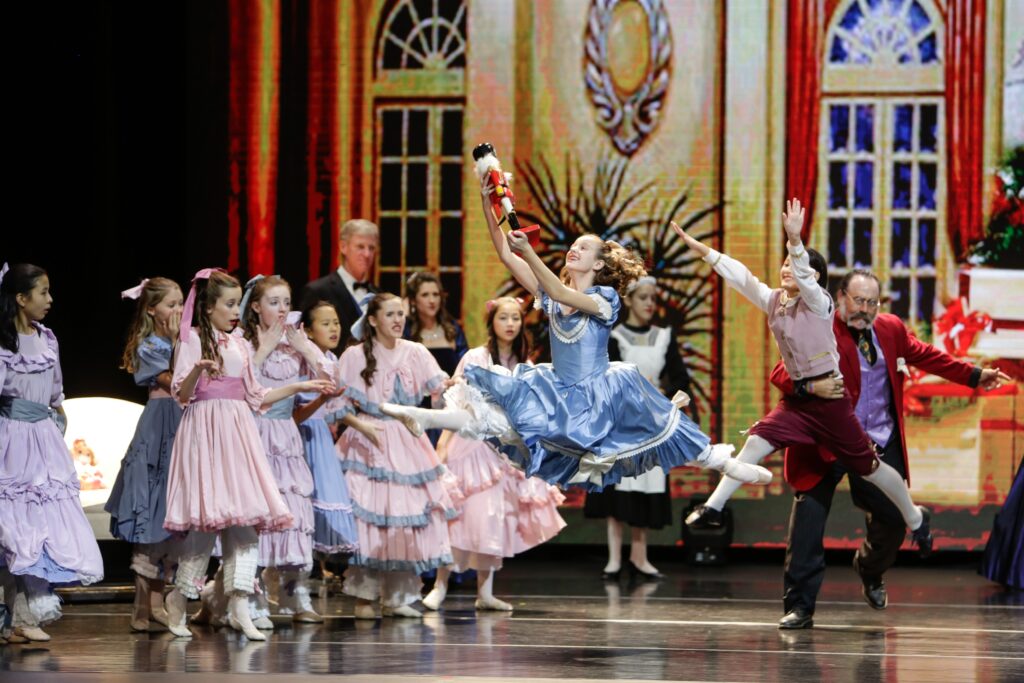
According to the program’s website, their purpose is to “emphasize character along with technique … to counter the natural tendency towards self-absorption in the ballet studio.”
They are “very committed to teaching children to dance — to develop discipline, technique and musicality. [But] the Christian instructors [also] train the students in a context that understands that there’s a reason to dance.”
30 years of dance and faith
Current director, Becky Brown, has led the school for several years, growing the program while faithfully following Perimeter Ballet’s original mission. She oversees weekly classes, summer dance camps and annual productions, including an acclaimed Spring Recital and a presentation of The Nutcracker each December.
For the 30th anniversary, Brown is excited to continue the creative work of the ballet school and share their artistry and message with a larger audience.
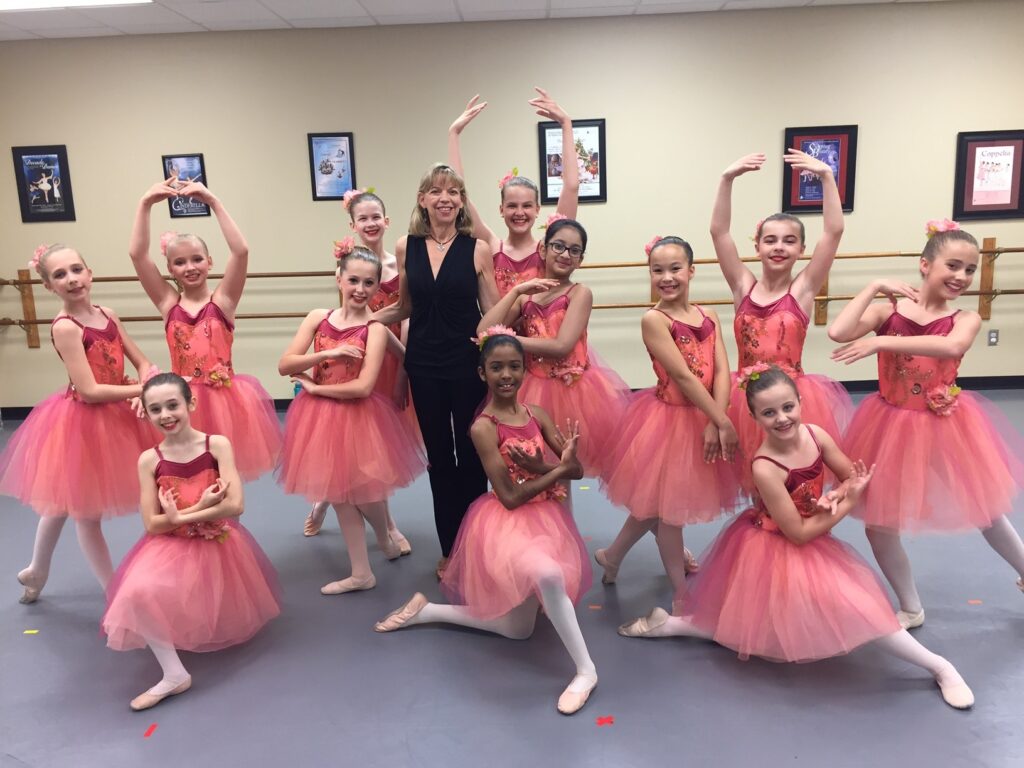
“This year will certainly be a special time for us as we celebrate and look back on 30 wonderful years of Perimeter Ballet and 20 years for our performing company, For His Glory,” she said. “We will be performing the Nutcracker December 11–13 and will have some beautiful new costumes to commemorate the occasion. We look forward to seeing many of our alumni and their families at the performance.”
Classes and instructors
Open to the community at large, weekly classes at Perimeter Ballet range from Creative Movement, PreBallet and grade-level classes for preschoolers through third grade to more advanced classes (two or more times per week) for older students.
Summer camp sessions as well as intermediate level and advanced level intensives are also offered. For the upper-level intensives, students work on their ballet technique but also branch out into jazz and other forms of dance.
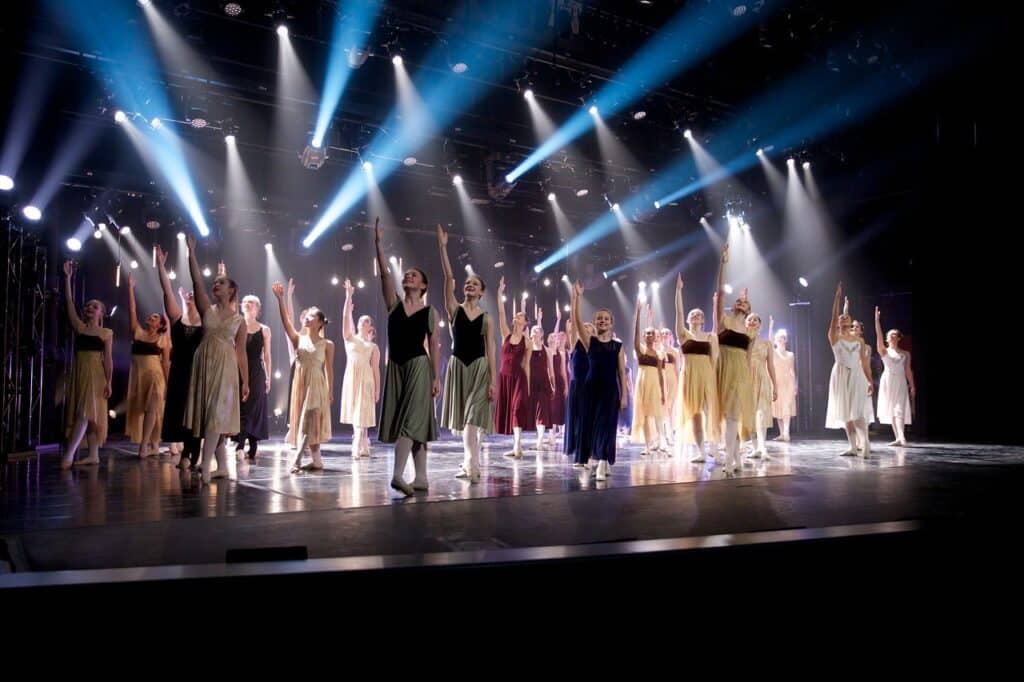
The school’s nine teachers are skilled not just as instructors but as performers themselves, having years of experience dancing with companies such as Ballet Southeast, Atlanta Ballet, North Atlanta Dance Academy and the Metropolitan Opera Ballet. They bring that experience and their Christian faith to all of their classes and interactions with the young students.
For His Glory
In addition to the work they do as a ballet school, Perimeter Ballet also has an audition-selected performance company — For His Glory.
With three levels, made up of dedicated students striving to advance their skills and reach their “God-given potential while giving glory to [their] Lord and Savior, Jesus Christ,” the program presents several high-quality productions throughout the year.
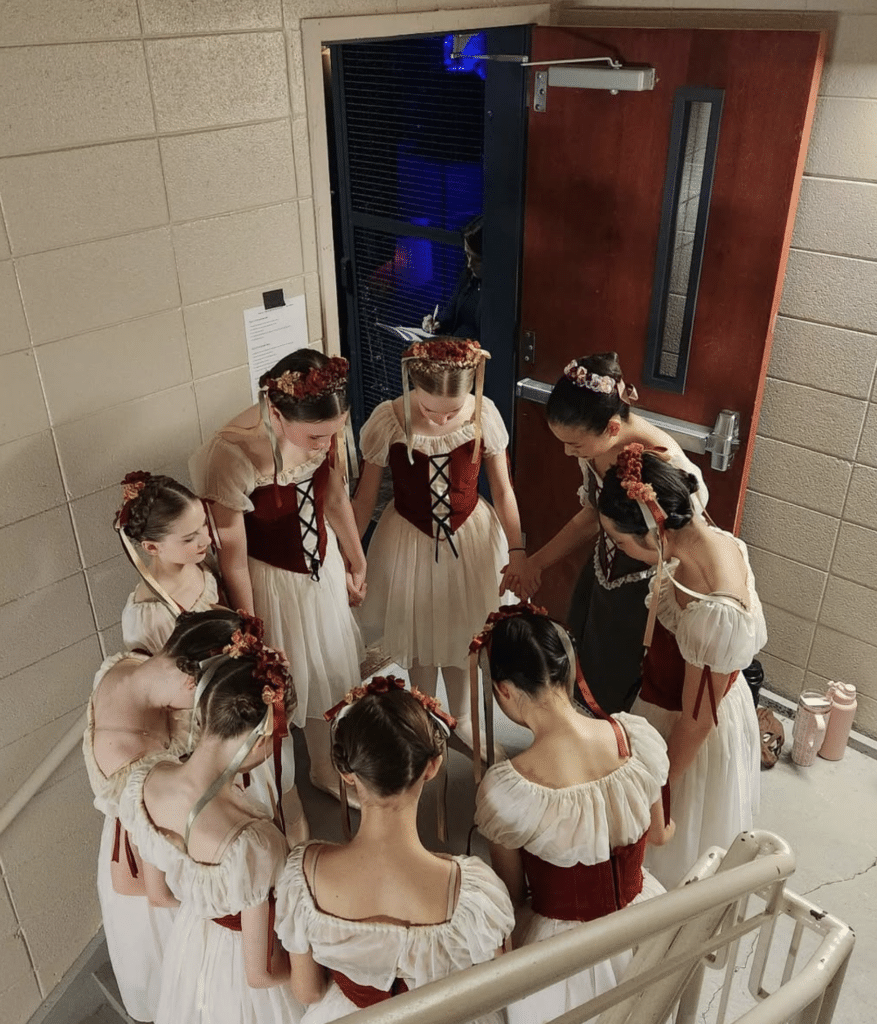
As Perimeter Ballet shares on their website: “Dancers are trained in the ballet classics as well as contemporary forms of dance, which are used in performances, worship settings and outreach. Classical ballets … in the group’s repertoire include Cinderella, Sleeping Beauty, Coppélia, excerpts from Four Seasons and La Fille Mal Gardee. In addition to Christmas and other outreach programs, For His Glory has danced internationally in London, India and Belarus.”
The group most recently performed Beauty & the Beast for two successful shows on stage at the Perimeter Church Sanctuary in early February of this year.
Impact and inspiration
All of this — the focus on faith and commitment to dance, the classes, intensives and stunning productions — have been a decades-long inspiration to the community and especially the student dancers who take part.
Many of the students stay with Perimeter Ballet for much of their childhood, learning and growing in dance as well as in their faith from elementary age through high school. That kind of involvement can clearly impact every aspect of their lives, from discipline learned to how they choose to interact with and be in the world.
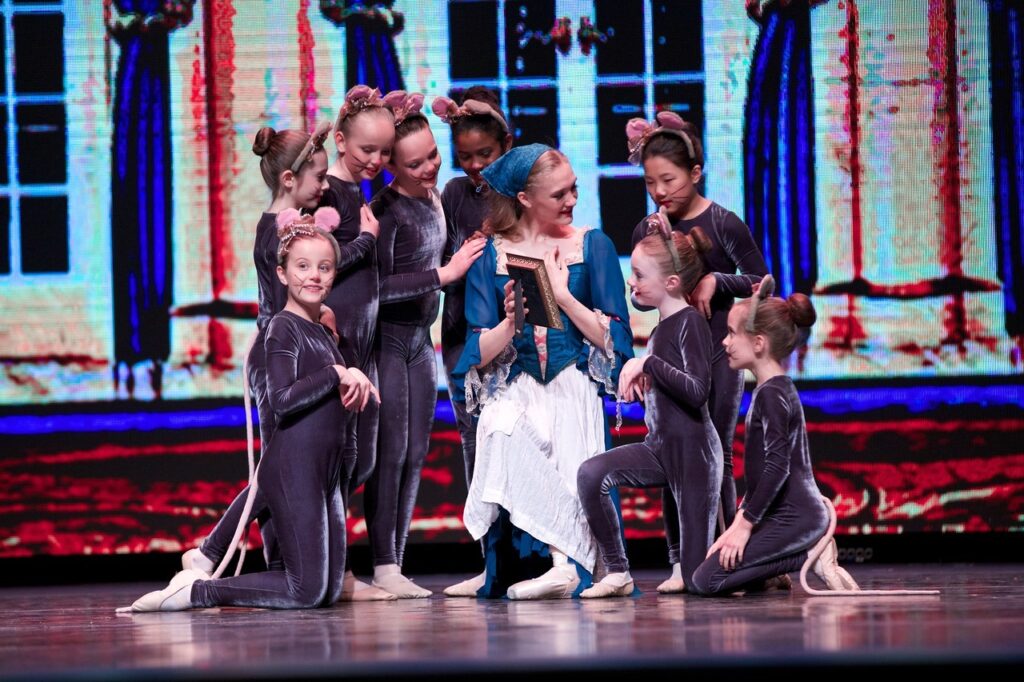
One student, Anne Bradley Maxwell has been taking ballet with the Perimeter program since she was three years old. Now a high school junior in Peachtree Corners, she’s reflected on her time at the school and in the performance company as well as Perimeter Ballet’s milestone anniversary.
“For fifteen years … I matured within this unique, local community arts program,” she shared. “This year marks the 30th anniversary of its founding … and I’m honored to say I’ve been a student for half of that era. The talented instructors in [the] program not only helped advance me into an accomplished ballerina but also into a more faithful servant of Jesus Christ using dance as a form of worship.”
A lifelong journey
“This lifelong journey included annual seasonal training, auditions, numerous external summer intensives and wonderful performances on stages across the nation and abroad, for audiences ranging from a few dozen to several thousand,” Maxwell continued.
“… Taking ballet has instilled in me a deep understanding of perseverance and resilience. Pursuing excellence in ballet required me to overcome physical and emotional challenges … I learned to seek out solutions — whether physical therapy for healing my body or prayer and reflection to rejuvenate my spirit. These experiences have strengthened my ability to face setbacks, adapt and emerge stronger.
Ballet has cultivated in me a unique combination of athleticism, discipline and creative imagination. The most elegant performances emerge from the interplay of technical mastery and creative expression. The collaborative nature of ballet, where individuals work in harmony to create something greater than themselves, informs my approach to teamwork and innovation, both in the classroom and community.”
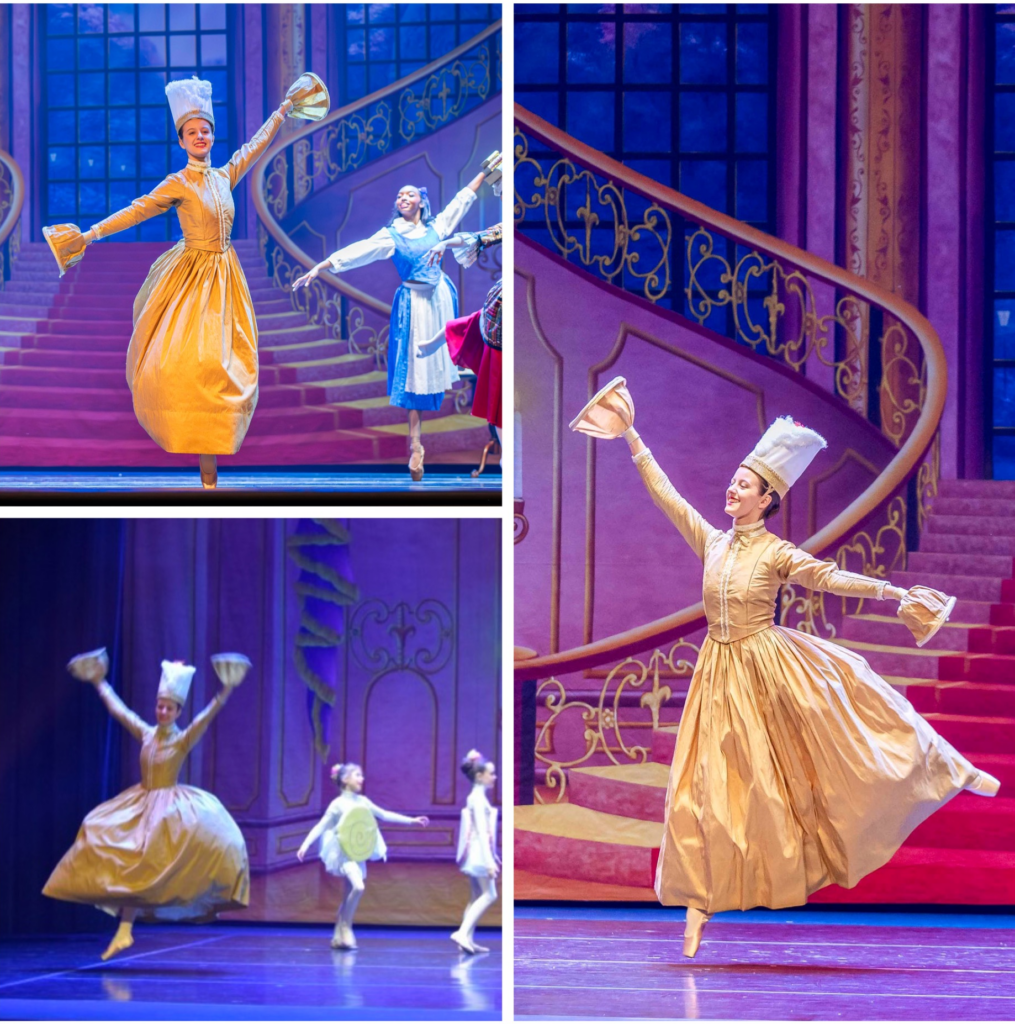
“… Ballet has [also] given me the gift of joy — both in experiencing it personally as a testament to Christ’s goodness and in sharing it with audiences. This joy, while intangible, is a powerful force that I hope to bring into my next chapters following high school. Whether through teaching movement, choreographing performances or exploring ways to expand ballet offerings, I aspire to enrich the community with the beauty and joy of dance.
… My time at Perimeter Ballet has equipped me with perseverance, discipline, creativity and a passion for sharing joy — qualities that I am excited to further cultivate as a young adult. These will not only enhance my personal journey but also contribute meaningfully to the rich tapestry of life. As I enter my senior year later this fall, I am full of gratitude for the solid foundation of technique and creative expression honoring God as the giver of my talent.”
Upcoming events
Perimeter Ballet’s Annual Spring Recital will be held in the Perimeter Church Sanctuary on Thursday, May 1 and Friday, May 2 from 7 p.m. to 8:15 p.m.
Summer camp sessions are scheduled for June and July. Registration will open on April 15.
2025-2026 classes will start in August with registration opening on April 15.
With help from Anne Bradley, the school is also planning a fundraiser event later in the year to mark the 30th anniversary.
For more information, visit perimeterballet.com.
Related
Read the Digital Edition
Subscribe
Keep Up With Peachtree Corners News
Join our mailing list to receive the latest news and updates from our team.
You have Successfully Subscribed!

GA Tech Launches First-of-its-Kind GT Atrium in Peachtree Corners

Katherine Lafourcade — A Journey of Passion, Resilience and Giving Back

Digital Edition

PCBA Announces 2025 Scholarship Winner

Paul Duke STEM High School Student Earns CGO Scholarship

World Blood Donor Day Starts Here: Theo’s Miracle, Katherine’s Mission [Podcast]

Peachtree Corners Grows Business Opportunities Through Economic Development

Executive Function: A Tribute to Working Moms

Simpson Elementary Marks Exceptional Children’s Week

Executive Function: A Tribute to Working Moms

Official City Merchandise Line Debuts This Saturday at Town Green

Peachtree Corners Grows Business Opportunities Through Economic Development

Digital Edition

World Blood Donor Day Starts Here: Theo’s Miracle, Katherine’s Mission [Podcast]

Paul Duke STEM High School Student Earns CGO Scholarship

PCBA Announces 2025 Scholarship Winner

Light up the Corners [Video]

Capitalist Sage: Business Leadership in Your Community [Podcast]

Cliff Bramble: A Culinary Adventure through Italy

Top 10 Brunch Places in Gwinnett County

A Hunger for Hospitality

THE CORNERS EPISODE 3 – BLAXICAN PART 1

Top 10 Indoor Things To Do This Winter

The ED Hour: What it takes to Remove Barriers from Education
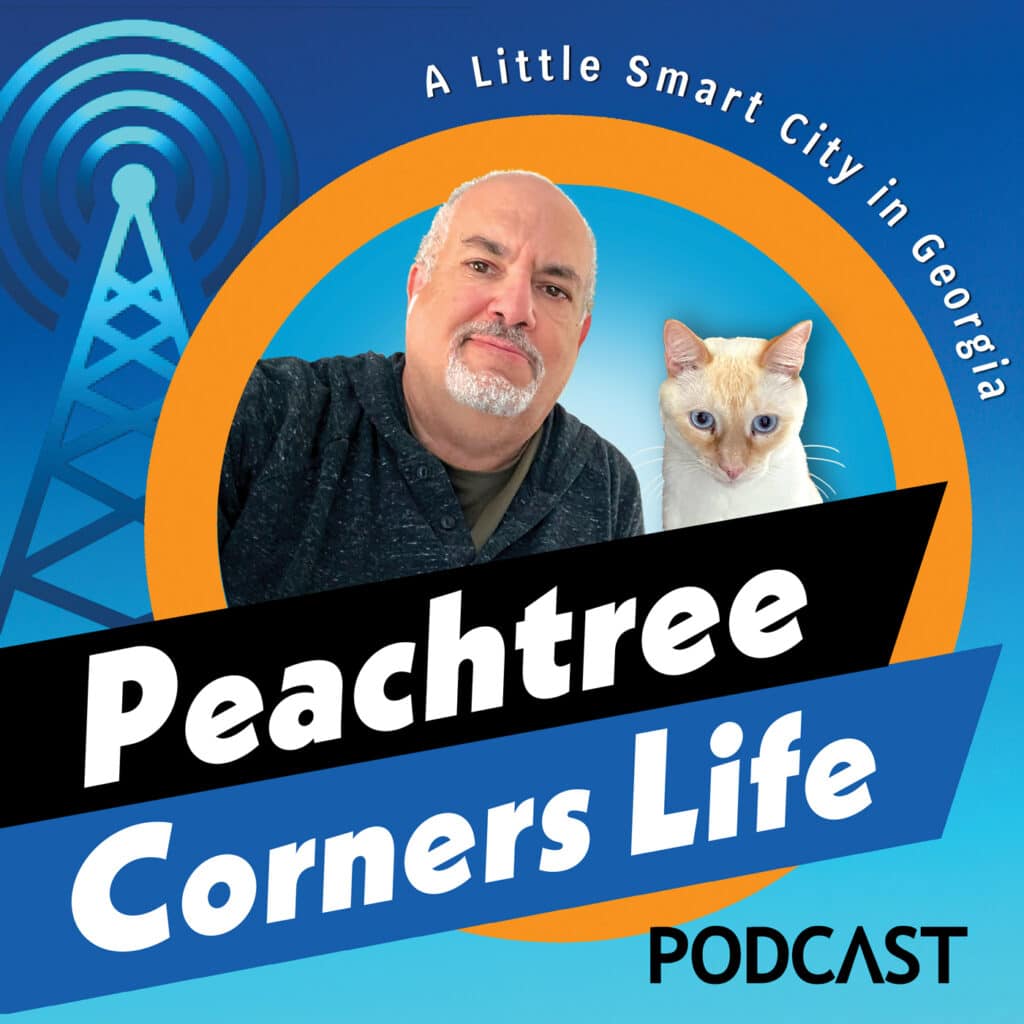
Peachtree Corners Life
Topics and Categories
Trending
-
Digital Edition4 days ago
Digital Edition
-
Podcast4 days ago
World Blood Donor Day Starts Here: Theo’s Miracle, Katherine’s Mission [Podcast]
-
Business3 days ago
Peachtree Corners Grows Business Opportunities Through Economic Development
-
Community2 days ago
Executive Function: A Tribute to Working Moms




